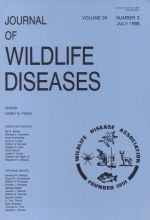The occurrence of tularemia was studied in 1,500 hares submitted to the National Veterinary Institute, Uppsala, Sweden for postmortem examination during 1973 through 1985. A total of 109 tularemia cases was recorded based on the fluorescent antibody (FA) test for Francisella tularensis and on the gross and microscopic pathology. Tularemia was diagnosed only in the varying hare (Lepus timidus) and not in the European brown hare (Lepus europaeus). The geographical distribution of the 109 cases indicates that tularemia has not spread in Sweden during the last 45 yr, with the exception of an endemic occurrence of the disease on the island of Stora Karlsö in the Baltic sea. The disease was most frequent in the autumn and only a few cases were recorded during winter. Cases were not seen in the spring. The annual prevalence varied, with several cases in 1974 and 1981, but there were no cases in 1976 and 1980. The postmortem findings in hares dying of tularemia in the autumn were characterized by focal coagulative necrosis in liver, spleen and bone marrow, with high numbers of bacteria FA-positive for F. tularensis. In hares dying during winter months, the most characteristic findings were hemorrhagic enteritis and typhlitis, although necrotic lesions could occur in liver, spleen and bone marrow. Diseased hares on the island of Stora Karlsö were demonstrated to be infected with ticks, while hares on the mainland of Sweden generally were fed upon by mosquitoes. Twenty-six of the 109 hares with tularemia were examined bacteriologically and F. tularensis biovar palaearctica was isolated from eight. The lung extract antibody test for F. tularensis was performed in 18 of the 109 hares. All were negative. In addition to the field study, an experimental study with F. tularensis biovar palaearctica was performed. Four varying hares and three European brown hares were inoculated. None of the hares died from tularemia, and generalized infection was not demonstrated.
How to translate text using browser tools
1 July 1988
INFECTIONS WITH FRANCISELLA TULARENSIS BIOVAR PALAEARCTICA IN HARES (LEPUS TUMIDUS, LEPUS EUROPAEUS) FROM SWEDEN
Torsten Mörner,
Gunnar Sandström,
Roland Mattsson,
Per-Olle Nilsson

Journal of Wildlife Diseases
Vol. 24 • No. 3
July 1988
Vol. 24 • No. 3
July 1988
ELISA
European brown hare
experimental infection
FA-test
Francisella tularensis biovar palaearctica
LEAT
Lepus europaeus




